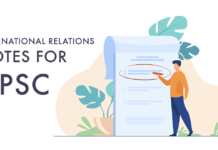Q. 1 (a) What do you understand by sustainable development? Discuss the relationship between the Environment and Development.
Or
“Development should be not at the cost of environment.” Explain this statement.
Q. 1 (b). What is ‘environmental pollution’? What are the factors which have caused environmental pollution?
Q. 1 (c) Briefly discuss various kinds of Pollution.
Q. 2. What is water pollution? Describe its sources. What is the position of water pollution in India?
Or
Write a note on the water pollution.
Q. 3(a) Discuss the sources of Land pollution. Describe the effects of Land Pollution.
Q. 3(b) What is Noise Pollution? Explain its sources and effects.
Q. 4. Discuss the various measures to control the Environmental Pollution.
Q. 5(a). Write short notes on the followings
1. Ecological Cycle
2. El-Nino Effect
Q.5(b). What is Green house effect? Discuss various developments which are taken against it as preventive measures.
Q. 5(c) Write a short note on the Kyoto Summit.
Q. 5(d) Write short notes on the followings :
1. Ecology system.
2. Ozone depletion.
3. Acid rain.
4. Effects of Plastic on environment.
5. Environment management.
Q. 6(a) “Environmental Pollution has become an international problem.” Discuss various developments in this regard.
Or
Describe the measures which have been taken for the prevention of environmental pollution on the International level.
Q.6(b) “Stockholm Declaration is the first document to the environmental protection on international level.” Explain this statement.
Or
“Stockholm Declaration is the Magna Carta of Environmental Protection.” Describe this statement.
Q. 6(c). Write a note on the Earth Summit or Rio Summit, 1992. Or What is Rio declaration? Explain in detail.
Q. 6(d). Write short note on Agenda 21.
Q. 7(a). Discuss the various provisions of Indian Constitution concerting Environment Protection.
Or
“India is the first country to provide constitutional protection to the environment.” Support the above statement by citing constitutional provisions and elucidate them.
Q. 7(b). Discuss in brief the role played by judiciary for the development of Environmental Law.
Or
Discuss the contribution of Judicial Activism for Environmental Protection.
Q. 7(c). Discuss the facts and decision of a case decided by the Supreme Court of India relating to environmental pollution.
Q. 7(d) What are the remedies available against the polluters? Discuss.
Or
Discuss briefly the remedies of injunction and damages against Polluters.
Q. 8(a). What are the various provisions for protecting environment in Indian Penal Code? Write in detail.
Q. 8(b) Discuss the protection and remedies available to a victim of pollution under the Law of Torts.
Or
Explain the remedies against the pollution which are available under the common lavv.
Q. 9(a). Define the following terms, as defined under the Environment (Protection) Act, 1986 : or Environment, Environmental Pollutant, Environmental Pollution, Hazardous Substance, Occupier, Handling.
Q. 9(b). Describe the appointment of. officers and their powers and functions under the Environment (Protection ) Act, 1986.
Q. 10 (a) Discuss the provisions regarding prevention, control and abatement of environmental pollution under the Environment (Protection) Act, 1986.
Q. 10(b) “Persons handling hazardous substance to comply with procedural safeguards.” Explain this statement.
Q. 10(c) Discuss the provisions under the Environment (Protection) Act, 1986 relating to the furnishing of information to authorities and agencies in certain cases.
Or
Under what circumstances the information may be given to authorities and agencies regarding environmental pollution?
Q. 10 (d) Who has power of entry and inspection for the prevention of environmental pollution? Discuss.
or
Explain the power of entry and inspection under the Environment (Mucci ion ) Act, 1986.
Q. 11(a) Explain the power to take sample and procedure in connection therewith as provided under the Environment (Protection) Act, 1986.
Or
Who is competent to take sample of air, water, soil or other substance for the purpose of analysis? Describe the procedure to be followed in connection therewith.
Q. 11(b) Explain clearly the various penal provisions for violation of the provisions of Environment (Protection) Act, 1986.
Or
Discuss the provisions of penalty for contravention of the provisions of the Environment (Protection) Act, 1986 and the rules and orders.
Or
Explain clearly the various penalties and offences under Environment (Protection) Act, 1986.
Q. 11(c). Discuss the objectives and functions of the Water (Prevention and Control of Pollution) Act, 1974.
Q. 11(d) Define the followings under the Water (Prevention and Control of Pollution) Act, 1974.
1. Occupier
2. Pollution
3. Sewage effluent
4. Trade effluent
5. Stream
6. Outlet.
Q. 12(a). Discuss the constitution of State Pollution Control Board.
Q. 12(b). Describe the powers and functions of Central Board.
Q. 12(c) Describe the Powers and Functions of State Board.
Q. 12(d). Discuss the power to take samples of effluents and the procedure to be followed in connection therewith and explain the law relating to the reports of the result of analysis on sample taken by the Board.
Or
Explain the power of the Board to take sample of effluents. What is the utility of its reports?
Q. 13(a) Discuss the Powers of Entry and Power of Inspection of the State Board.
Q. 13(b) What are the measures which can be adopted by the Board for prohibition of water pollution under the Water (Prevention and Control of Pollution) Act, 1974?
Or
Discuss the restrictions which are imposed by the Board for prohibitting water pollution.
Q. 13 (c). Discuss the provisions regarding appeal and revision under the Water (Prevention and Control of Pollution) Act, 1974.
Or
What are the remedies available to the applicant against the withdrawal in refusal of consent by State Board under Section 25, 26 or 27 of the Act?
Q. 13(d) Who is empowered to entertain applications of Board for restrains nµ apprehended pollution of water in streams and well? Discuss.
Or
Explain the power of Board to make application to courts for restraining apprehended pollution of water in stream and wells under Section 33 of the Water Act.
Q. 14(a) Discuss the penal provisions under the Water (Prevention and Control of Pollution) Act.
Or
What are the penal proceedings which can be taken in case of failure to comply with the directions for emergency measures in cases of pollution?
Or
What are the penalties for violation of provisions of the Act?Or What penalties can be imposed on failure to comply with direction of the State Board under the Act?
Q. 14 (b). Explain and discuss the objects and main provisions of Air (Prevention and Control of Pollution) Act, 1981.
Or
Descuss the necessity of Air (Prevention and Control of Pollution) Act, 1981.
Q. 15. Define the following terms under the Air (Prevention and Control of Pollution) Act, 1981 :
1. Air Pollutant
2. Approved appliance
3. Automobiles
4. Approved fuel
5. Chimney
6. Control equipment
7. Emission
8. Industrial Plant
9. Occupier
Q. 16 (a). Discuss the law relating to meetings of Central Boards and constitution of Committees of the Board under the Air (Prevention and Control of Pollution) Act, 1981.
Q. 16 (b) Discuss the function of Central Board constituted under the Air (Prevention and Control of Pollution) Act, 1981.
Q. 16 (c) Explain the powers and functions of the State Board Linder the Air (Prevention and Control of Pollution) Act, 1981.
Q. 16 (d) Discuss the provisions relating to prevention and control of air pollution.
Q. 17 (a). Describe the power to obtain information and power to take sample to be taken under Section 26. Explain the procedure to be followed regarding reports of the result of those sample. Or Discuss the power of a State Board to take samples of air emission and procedure to be followed in connection therewith as provided under the Air (Prevention and Control of Pollution) Act, 1981.
Q. 17. (b) Explain the objects and main provisions of Indian Forest Act, 1927.
Q.18 (a). What provisions are laid down in the Indian Forest Act, 1927 regarding Reserved Forest? Explain.Or Explain the Power and Procedure of State Government to Reserve Forest.
Q. 18 (b ) Discuss the consequences of declaration of Reserved Forest?
Q. 18 (c) What do you understand by Protected Forests? State the powers of Government regarding Protected Forest.
Q. 18 (d). What am the provisions under the Indian Forest Act, 1927 for the control over forest and lands not being the property of Government? Discuss.
Q. 19 (a) Explain objects and provisions of the Wild Life Protection Act in brief.
Q. 19 (b) Discuss the provisions regarding hunting of wild animals under the Wild Life Protection Act, 1972.
Q. 19 (c). How are the Sanctuaries constituted by the State Government? Explain.
Q.19 (d). Describe the provisions given in relation to the restriction on entry and permission for entry in sanctuaries.
Q.20 (a). What provisions are laid down in the Wild Life Protection Act with regard to National Park?
Q. 20 (b) Write in brief the object and purpose of National Environment Appellate Authority Act, 1997 and constitution, power and functions of the Authority appointed thereunder.









